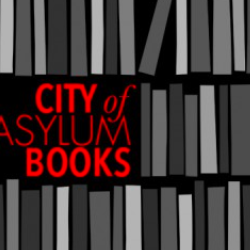Meena Kandasamy: Angry Young Women Are Labelled Hysterics
by Silvia Duarte / September 22, 2010 / 2 Comments
When Meena Kandasamy speaks about the contemporary issues of her native India, she incisively reveals the societal assumptions that assign specific roles to people based on caste or gender. When she turns her attention to the past, she deconstructs the heroes. She uses her poetry like a scalpel to dismantle stereotypes.
In 2009, Kandasamy came to Pittsburgh to read at City of Asylum/Pittsburgh’s Jazz Poetry Concert. Since then, Sampsonia Way has followed the career of this 26-year-old poet, translator, and creative writer.
Kandasamy’s work articulates the voice of the Dalits, the people at the lowest rung of India’s ancient caste system. Despite the fact that the Indian constitution abolished this system, the Dalits still face widespread discrimination.
Kandasamy recently finished her second book of poetry, Ms. Militancy to be published by Navayana Press in November. In this collection, she retells Hindu and Tamil myths from a feminist and anti-caste perspective.
In this interview she calls herself “an angry young woman,” attacks academic language, and relates how she has faced harassment from people who feel assailed by her writing.
In a recent interview with Sampsonia Way writer Horacio Castellanos Moya said, “if you have some kind of sensibility towards injustice, you know what rage is.” Your poems have huge doses of rage. How do you deal with anger when you are writing?
I am an angry young woman. The world has not seen enough of our kind, while we have had plenty of angry young men. Angry young men working among the people are killed early; angry young men becoming artists spend a lifetime in anonymity; and savvy angry young men turn into politicians and all the revolution inside them simply fizzles out.
However, society will not let angry young women exist, we will be labelled hysterics. As women, we are indoctrinated merely to accept our situation and be grateful for all the things we have. As women, we are told that it is bad behavior to be angry, we are told that we have to change ourselves because we cannot change the system. Those of us who refuse to comply are the shrews whom everyone loves to hate.
In all this social conditioning, we tend to forget that anger is only a reaction to something outside of oneself, a reaction to an oppressive system. I write as an angry young woman, even as it requires all my artistic skill to maintain that rage and to let it reflect in my writings.
Why did you choose poetry as your sword against discrimination?
Poetry is not caught up within larger structures that pressure you to adopt a certain set of practices while you present your ideas in the way that academic language is. Despite being an academic myself, I dread academia’s ultra-intellectualizing. Perhaps academic jargon does contribute a lot to philosophy—to late-night conversations in air-conditioned rooms with plenty of red wine and Swiss cheese. I can fake that routine, trust me, I pull it of like a real pro. Sometimes, I even subject myself to that horror for pure, wicked pleasure. But is it the language to speak of the oppressed? Is it the language in which any victim would speak?
However, you are a Ph.D. candidate in linguistics and English literature and recently completed your dissertation. How do you deal with academic language?
I often die a death within myself when I am asked to theorize my struggle and present it to scholars. In my mind, this image plays: I am an abused naked woman, I am through trauma, and I go around with a begging bowl. I am not pleading. I am not even fighting at this stage. I am out there collecting words, fancy words in a foreign tongue that I must reproduce in order to be heard, in order for my circumstance to be understood. The same thing happens when you are working with human rights organizations, with NGOs, and with lobby groups.
What kind of language should be used?
Whether it is the Dalits in India or the Tamils in Sri Lanka, there is immense discrimination, there is daily violence, there are unbearable tragedies. But to get people to hear, to get the international community to even blink in our direction, we have to learn a jargon-laden language that they will understand. We have to use a pacifist language that does not point and blame, a passive language that forces your eyes to become mere video-capture devices, a pointless language of emotionicide, a carefully-constructed language that pushes you into a paralysis. Consequently, we languish as a society.
So, do you see your poetry as the antithesis of this paralysis?
Yes. Poetry, it is raw. It is real. It is full of jagged edges. My poetry is naked, my poetry is in tears, my poetry screams in anger, my poetry writhes in pain. My poetry smells of blood, my poetry salutes sacrifice. My poetry speaks like my people, my poetry speaks for my people.
In the poem “Nailed” you write, “Men are afraid of any woman who makes poetry and dangerous portents.” How have men and members of the other groups you criticize responded to your work?
There are men who take great interest in writing obscene emails to me, but their lack of imagination makes for rather depressing reading. Others say that I am “terrorizing” the caste-Hindus with my writing. Very often I know that this anger is because of the political, anti-caste stand I adopt.
When I wrote an article attacking the anti-Muslim hatred in the novelist V. S. Naipaul’s writings, someone wrote, “Is Meena Kandasamy your pedophile prophet’s preteen wife?” on an internet forum. I bring on extreme emotions in people. I have been called all kinds of names. There are hate-mongers who write to me saying that they will come to my city and finish off my career.
It sounds like criticism has turned into threats.
Increasingly, the criticism has also become personal and malicious as well. There is a new breed of moral police who attack me for my writings. There was a woman who said that I write about my body as a way to garner male-attention and she blamed men who posted comments on my Facebook status updates. Sometimes, hatred can provide a lot of amusement!
Being a writer has made me blind and totally brazen. My family and friends are afraid for me. I have been stalked to my hotel and received anonymous threats. At times like that, I am a little scared. I later console myself and gain confidence with the fact that any physical attack on me will only draw more attention and garner a larger audience for my protest against caste discrimination and other issues.
In your poem “Mohandas Karamchand” you wrote to Gandhi: “Don’t ever act like a holy saint. / we can see through you, impure you. / Remember, how you dealt with your poor wife. / But, they wrote your books, they made your life.” What happened when you published this poem?
I was both cheered and reprimanded. To talk solely about the harassment I faced is to portray only one side of the story. Dalits welcomed the poem, Communists welcomed the poem, Muslims welcomed the poem and, above all, most women appreciated the poem. They could never come to term with Ghandi’s sexual experiments (which included sleeping next to naked young women to ‘test’ his vows of celibacy), or how hard he was on his wife, Kasturba. Gandhi supported the revival of the varnashrama dharma (the caste system’s insistence of people only working in their traditional occupations), and he used techniques of blackmail to prevent Dalits from attaining political autonomy and the right to govern themselves.
Sylvia Plath’s poem “Daddy” influenced me a great deal. When I saw what she had done, I thought, “Well, there’s a figure I would like to take on too.” Even today, it is my most popular (although no longer the most controversial) poem. The best thing about poetry is that it opens up space for discussion, a space for a critical revaluation.
According to the Committee to Protect Journalists, “Freedom of speech and expression in India is balanced precariously between the ever-present threat of direct, physical attacks from both security forces and social vigilante groups on the one hand, and the reassurance of protection from higher judicial authorities on the other. But the scales seem tipped in favor of the former.” How would you describe freedom of expression in India?
I am proud of quite a few things about my country. One is its constitution, which enshrines the right to freedom of expression for instance. But, is there a thriving freedom of expression? Of course not.
Films are regularly and brutally censored for their politics. Women poets are attacked when they write about sexuality by the so-called moral police. Tamil leaders are jailed when they speak of the right to self-determination and human rights for their people. The state labels them as “secessionists” and says they are a threat to national integrity. The state routinely criminalizes Muslim, Dalit, and Adivasi [indigenous people of India] leaders because they challenge the oppressive system. Journalists have been taken in for questioning and some end up being killed in ‘fake encounters’ by the state. As Indians, we are not totally shocked because our neighboring countries do much worse.
Look at Sri Lanka for example, it has one of the worst records of assassinating, abducting, incarcerating members of the media or anyone who decides to expose human rights abuses or the genocide of the Tamils. So, as Indians, we perhaps draw comfort from the fact that things are much worse elsewhere even as we fight hard to not to lose freedom of expression.
Read poetry from Meena’s Ms. Militancy.
Read Silvia’s bio.







2 Comments on "Meena Kandasamy: Angry Young Women Are Labelled Hysterics"
Trackbacks for this post